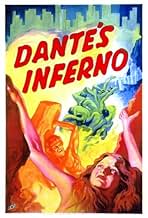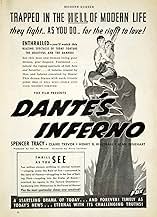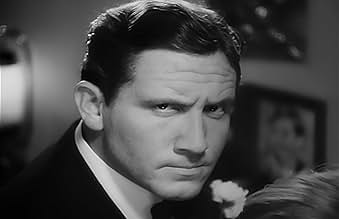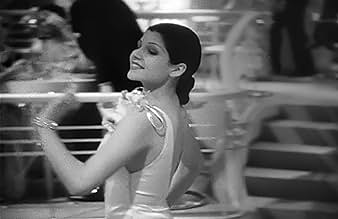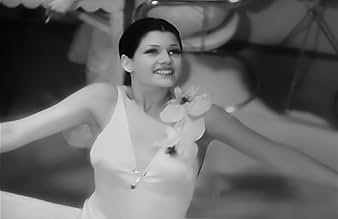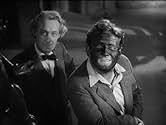PUNTUACIÓN EN IMDb
6,6/10
985
TU PUNTUACIÓN
Un charlatán de feria arma un barco de recreo y juego, provocando una catástrofe en la travesía inaugural, al permitir un exceso de carga.Un charlatán de feria arma un barco de recreo y juego, provocando una catástrofe en la travesía inaugural, al permitir un exceso de carga.Un charlatán de feria arma un barco de recreo y juego, provocando una catástrofe en la travesía inaugural, al permitir un exceso de carga.
- Dirección
- Guión
- Reparto principal
- Premios
- 1 nominación en total
Scotty Beckett
- Alexander Carter
- (as Scott Beckett)
Rita Hayworth
- Dancer
- (as Rita Cansino)
Astrid Allwyn
- Girl in Stoke-Hold
- (sin acreditar)
Don Ameche
- Man in Stoke-Hold
- (sin acreditar)
Oscar Apfel
- Mr. Williams
- (sin acreditar)
Mary Ashcraft
- Girl in Stoke-Hold
- (sin acreditar)
Gertrude Astor
- Concessionaire's Wife
- (sin acreditar)
Frank Austin
- Photographer
- (sin acreditar)
Zita Baca
- Passenger in Boiler Room
- (sin acreditar)
Lynn Bari
- Amusement Park Patron
- (sin acreditar)
Reseñas destacadas
There is no denying that Dante Alighieri is not only a major literary figure of Italy's Renaissance, but one of the world's greatest poets. Actually he left many poems in his works, especially regarding the forbidden love of his life Beatrice, but the poem most associated with him is a 33 canto poem entitled INFERNO. Most people don't realize it is actually the first third of a larger book of poetry called THE DIVINE COMEDY. Dante wrote three sections of this book, in which he, a traveller, is escorted by the ghost of the Latin poet Virgil through the nine levels of Hell, then into purgatory, and finally into paradise. The conclusion of the poem is when Dante is able to see the grandeur and beauty of God's love, which is the ultimate position at the top of the universe's order. Although Purgatory and Paradise have moments of exceptional power in them, they are less exciting than the human tragedies that make up the cantos of The INFERNO. What story about redemption or love can compete with the hideous doom of Count Ugolino of Pisa and his children, condemned to starve to death by a political enemy (Ugolino had betrayed the enemy, once a friend of his). The punishment is very gruesome - Ugolino is forever hungry for his crimes, and is gnawing at the brain of his political foe forever as a result.
Nothing quite that gaudy here - The central figure (Tracy) begins as a stoker, but slowely rises in the world, frequently not realizing that his greed and drive have alienated friends and relatives. The source of his wealth is the carnival and gambling empire he has put together. In the course of building it he meets Henry Walthall, who wants to build a midway building that shows Dante's Inferno - Walthall believes it will be beneficial to the public as it will show the public the dangerous ice they are on if they continue to sin. Of course this is the screenwriter's take on Dante's Divine Comedy, and the Inferno in particular - actually Dante is far too clever a poet to have such a trivial motive in the actual work for writing it that way.
That Tracy is saved in the end is due to heeding the wisdom of his friend (later his father-in-law)and due to a sea tragedy - Tracy's latest addition to his empire is a gambling ship, which catches fire off the coast of the U.S., and requires Tracy's leadership qualities to save the passengers and crew. A suitable fiery conclusion to the film - and also an historic footnote: the boat is made to resemble the ill-fated Morro Castle, which burned in a fire in 1934 (the year before this film) off the coast of New Jersey, killing 130 passengers and crew. As such, this is the sole movie I know of that refers to that disaster, except for a line of dialogue in the contemporary satiric comedy BOY MEETS GIRL.
Nothing quite that gaudy here - The central figure (Tracy) begins as a stoker, but slowely rises in the world, frequently not realizing that his greed and drive have alienated friends and relatives. The source of his wealth is the carnival and gambling empire he has put together. In the course of building it he meets Henry Walthall, who wants to build a midway building that shows Dante's Inferno - Walthall believes it will be beneficial to the public as it will show the public the dangerous ice they are on if they continue to sin. Of course this is the screenwriter's take on Dante's Divine Comedy, and the Inferno in particular - actually Dante is far too clever a poet to have such a trivial motive in the actual work for writing it that way.
That Tracy is saved in the end is due to heeding the wisdom of his friend (later his father-in-law)and due to a sea tragedy - Tracy's latest addition to his empire is a gambling ship, which catches fire off the coast of the U.S., and requires Tracy's leadership qualities to save the passengers and crew. A suitable fiery conclusion to the film - and also an historic footnote: the boat is made to resemble the ill-fated Morro Castle, which burned in a fire in 1934 (the year before this film) off the coast of New Jersey, killing 130 passengers and crew. As such, this is the sole movie I know of that refers to that disaster, except for a line of dialogue in the contemporary satiric comedy BOY MEETS GIRL.
Made at the height of the Great Depression this film is really a shout out to those unscrupulous money makers and a warning that eventually they will pay. When confronted by his Wife about his dirty deeds the Hero/Villain says..."I didn't do anything that any other businessman wouldn't have done".
This is a stand alone film that is unique, off beat, wild and profound. A visual display of a catastrophe of material and man. It is a stunning piece of work that was rarely shown on television and ignored as a bastard child of the bijou. The middle inclusion of a horrific Hell with suffering half-naked souls and with haunting, chilling musical accompaniment is partly responsible.
There are three set pieces in this remarkable movie that are unforgettable and the story of greed and decadence is timeless. This is a one of a kind, disturbing adventure put together with excellent special effects, costumes, and sets. An underrated, overlooked antique piece of propagandized art that remains relevant. "things don't change, the behavior of men remains the same throughout history", says the old man. Amen.
This is a stand alone film that is unique, off beat, wild and profound. A visual display of a catastrophe of material and man. It is a stunning piece of work that was rarely shown on television and ignored as a bastard child of the bijou. The middle inclusion of a horrific Hell with suffering half-naked souls and with haunting, chilling musical accompaniment is partly responsible.
There are three set pieces in this remarkable movie that are unforgettable and the story of greed and decadence is timeless. This is a one of a kind, disturbing adventure put together with excellent special effects, costumes, and sets. An underrated, overlooked antique piece of propagandized art that remains relevant. "things don't change, the behavior of men remains the same throughout history", says the old man. Amen.
Spencer Tracy travels the seven rungs of hell in "Dante's Inferno," a 1935 film costarring Claire Trevor and notable for a dance sequence featuring Rita Hayworth, still Rita Cansino. I actually hadn't realized Hayworth was in the film, but when I saw the dancer's smile, I recognized her immediately.
Tracy plays a man who lucks into carnival barking as a result of meeting a man, played by Henry B. Walthall, who runs a concession known as "Dante's Inferno." Walthall soon becomes Tracy's father-in-law, and Tracy becomes a successful businessman.
He launches a huge, gaudy Inferno employing ruthless means to get the property. Though a wonderful husband and father, in his corporate world, he stops at nothing to get what he wants, including cheating, bribery, and ignoring possible dangers. The consequences are disastrous.
The film has an obvious allegory, and I'm still laughing at a previous poster who noted that when Walthall goes through a book with Tracy and the seven rungs of hell come to life, everyone had great physiques so hell must not take chubsters! It's true!
Other than hell's preference for perfect 10s, the effects are amazing - the Inferno concession, the images in the book that come to life, and the fantastic ship scene which uses the Inferno images to great effect.
Spencer Tracy is excellent in his role, a tender dad, sweet husband and cruel businessman all at the same time. Claire Trevor is young and lovely and provides strong support for Tracy.
A very interesting film and highly recommended.
Tracy plays a man who lucks into carnival barking as a result of meeting a man, played by Henry B. Walthall, who runs a concession known as "Dante's Inferno." Walthall soon becomes Tracy's father-in-law, and Tracy becomes a successful businessman.
He launches a huge, gaudy Inferno employing ruthless means to get the property. Though a wonderful husband and father, in his corporate world, he stops at nothing to get what he wants, including cheating, bribery, and ignoring possible dangers. The consequences are disastrous.
The film has an obvious allegory, and I'm still laughing at a previous poster who noted that when Walthall goes through a book with Tracy and the seven rungs of hell come to life, everyone had great physiques so hell must not take chubsters! It's true!
Other than hell's preference for perfect 10s, the effects are amazing - the Inferno concession, the images in the book that come to life, and the fantastic ship scene which uses the Inferno images to great effect.
Spencer Tracy is excellent in his role, a tender dad, sweet husband and cruel businessman all at the same time. Claire Trevor is young and lovely and provides strong support for Tracy.
A very interesting film and highly recommended.
"Dante's Inferno" (1935) is a taut drama starring Spencer Tracy as a ruthless promoter who's determined to succeed, no matter who gets in his way. Eventually he gets a glimpse of Hell and sees the error of his ways ... but is it too late for him to repair all the damage he's done to other people's lives?
This film was inspired by (but is not a remake of) a 1924 film with the same title: both films have the same premise but very different plotlines.
We first see Tracy's character Jim Carter on the bottom rung: the Depression is on, and Carter is so desperate he takes a job as a blackface performer. Then he gets a job in a carnival attraction which offers the customers a quick ride through Hell (made of papier-mache).
There's a brilliant performance by Alan Dinehart, one of those great supporting actors from Hollywood's golden age. Dinehart specialised in playing sharp guys on the edge of the law (or slightly beyond it), and this is one of Dinehart's best roles. Henry Walthall, the silent-film star, is also excellent here.
The standout sequence in the film begins when Tracy is in hospital, recovering from injuries. Walthall brings him a copy of Dante's "Inferno", and proceeds to describe the horrible fates awaiting sinners in the afterworld. On screen, we see a series of stark tableaux in which naked men and women suffer eternal torments in Hell ... dodging flames, writhing in chains, turning into trees. For some reason, all the naked people in Hell have gorgeous physiques: apparently Hell doesn't take any chubsters.
"Dante's Inferno" is often mentioned by Rita Hayworth fans, because this movie includes one of her very earliest film roles. (She was still performing as Margarita Cansino, her original name.) Hayworth/Cansino appears very briefly as a ballroom dancer aboard Tracy's gambling ship. This is a standout film, but if you think it's a Rita Hayworth movie you'll be disappointed.
I strongly recommend "Dante's Inferno".
This film was inspired by (but is not a remake of) a 1924 film with the same title: both films have the same premise but very different plotlines.
We first see Tracy's character Jim Carter on the bottom rung: the Depression is on, and Carter is so desperate he takes a job as a blackface performer. Then he gets a job in a carnival attraction which offers the customers a quick ride through Hell (made of papier-mache).
There's a brilliant performance by Alan Dinehart, one of those great supporting actors from Hollywood's golden age. Dinehart specialised in playing sharp guys on the edge of the law (or slightly beyond it), and this is one of Dinehart's best roles. Henry Walthall, the silent-film star, is also excellent here.
The standout sequence in the film begins when Tracy is in hospital, recovering from injuries. Walthall brings him a copy of Dante's "Inferno", and proceeds to describe the horrible fates awaiting sinners in the afterworld. On screen, we see a series of stark tableaux in which naked men and women suffer eternal torments in Hell ... dodging flames, writhing in chains, turning into trees. For some reason, all the naked people in Hell have gorgeous physiques: apparently Hell doesn't take any chubsters.
"Dante's Inferno" is often mentioned by Rita Hayworth fans, because this movie includes one of her very earliest film roles. (She was still performing as Margarita Cansino, her original name.) Hayworth/Cansino appears very briefly as a ballroom dancer aboard Tracy's gambling ship. This is a standout film, but if you think it's a Rita Hayworth movie you'll be disappointed.
I strongly recommend "Dante's Inferno".
Spencer Tracy ruthlessly works his way up from carnival barker to owner to mogul, not caring who he hurts along the way. Excellent drama with some really nice set pieces and memorable scenes. Tracy, as always, is solid. Claire Trevor is good. Fine actor Henry B. Walthall steals every scene he's in. Scotty Beckett is adorable as Tracy's son. A young Rita Hayworth has a dancing scene but no lines. Excellent direction from Harry Lachman. Great sets and effects. Among the highlights are a shocking suicide, the much-praised "hell" sequence, and a thrilling shipboard fire climax. It's an evocative film that certainly stands as one of Spencer Tracy's best and most underrated films from the 1930s.
¿Sabías que...?
- CuriosidadesSpencer Tracy's erratic behavior on this film helped seal his fate with 20th Century-Fox. During filming Tracy disappeared from the set for weeks while on a drunken binge. He reportedly also showed up to the set one day surly and hung over and fell asleep in the "Manhattan apartment" set. The studio locked the stage while he was still asleep; Tracy woke up in a rage and started destroying sets, reportedly causing thousands of dollars worth of damage for which the studio billed him.
- PifiasTodas las entradas contienen spoilers
- ConexionesEdited into Myra Breckinridge (1970)
- Banda sonoraThe Wedding March
(1843) (uncredited)
from "A Midsummer Night's Dream, Op.61"
Written by Felix Mendelssohn
Played on a hurdy-gurdy for the wedding photograph
Selecciones populares
Inicia sesión para calificar y añadir a tu lista para recibir recomendaciones personalizadas
- How long is Dante's Inferno?Con tecnología de Alexa
Detalles
- Fecha de lanzamiento
- País de origen
- Idioma
- Títulos en diferentes países
- Dante's Inferno
- Localizaciones del rodaje
- Ocean Park Pier, Santa Mónica, California, Estados Unidos(exterior views showing rides including Loop-O-Plane and Chute-the-Chutes)
- Empresa productora
- Ver más compañías en los créditos en IMDbPro
Taquilla
- Presupuesto
- 748.900 US$ (estimación)
- Duración
- 1h 29min(89 min)
- Relación de aspecto
- 1.37 : 1
Contribuir a esta página
Sugerir un cambio o añadir el contenido que falta

